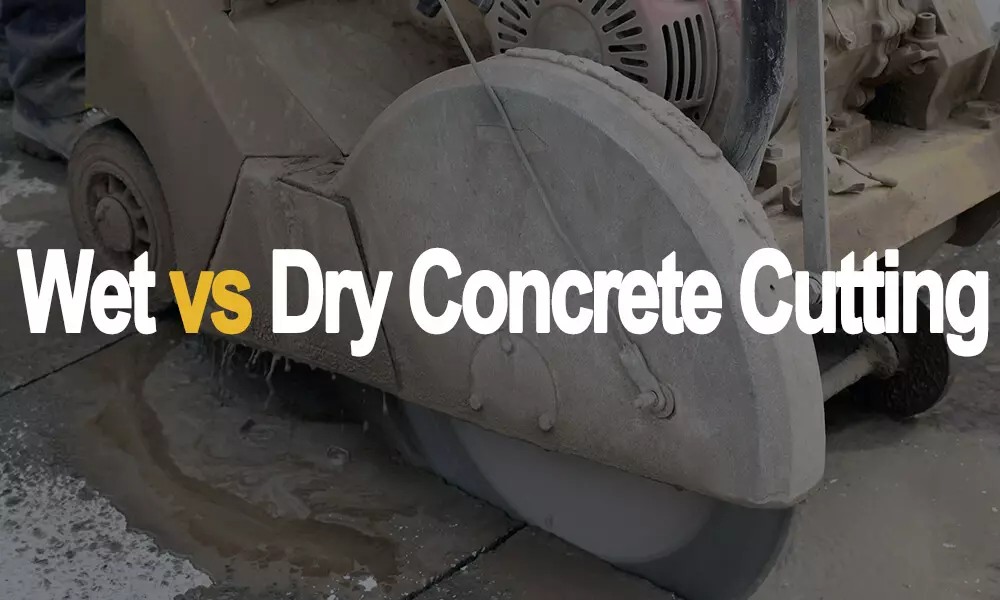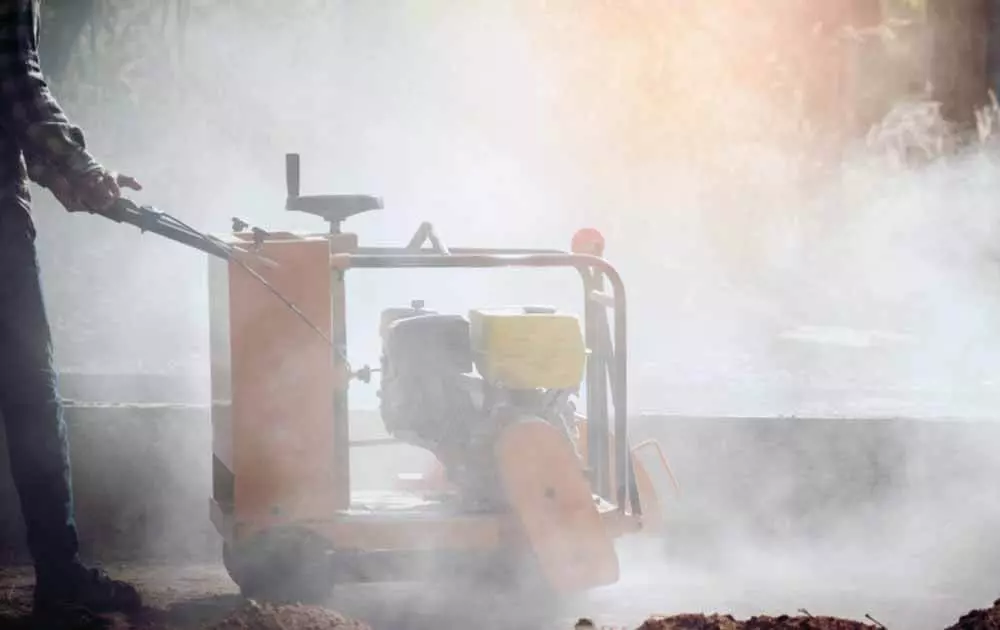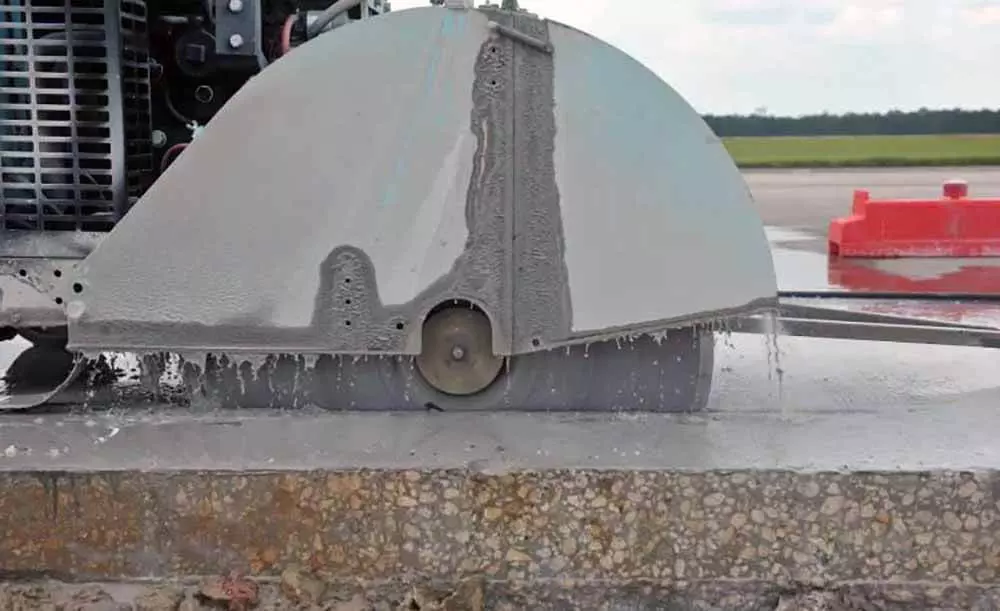26Jul 2023
table of contents

While there are many specific sawing techniques, diamond cutting is one of the most popular. Diamond saws are known for cleaner cuts because they are less likely to fracture the concrete surface. They have embedded synthetic diamonds into the saw blades, and when the crystals fracture, they produce more cutting surfaces. Thus, the saw becomes more efficient with use. Diamond blades make high-quality cuts that are wear-resistant and last longer.
While both sawing methods use diamond blades, some critical differences exist between dry and wet concrete cutting. Understanding how these two sawing technologies work and choosing the right one for your application is vital.
Dry cutting uses specialized diamond blades that can withstand more heat. It is most commonly used in small construction with a low-horsepower hand saw. Without water cooling, the saw uses the surrounding air to cool the blade, so it must rotate freely between cuts to increase airflow. You can pair a dry saw with a duster or vacuum to collect concrete dust in a bag.
BISON handheld dry-cutting saws should only be used for cuts 1.5 inches deep per cut and must be cooled between cuts.
Dry-cutting concrete has many benefits, including:
Simplified cutting: Dry cutting produces shallow, straight cuts. It makes these simple tasks much more straightforward.
No water is required: Wet cutting needs a continuous supply of pressurized water. On the other hand, dry cutting employs airflow to avoid getting too hot. Dry cutting is used when there is no water source or when the job site needs to be kept dry at all times, such as indoor construction.
A cleaner job site: During wet cutting, water combines with dust to form a concrete slurry. This minimizes or reduces dry particles in the air, it can create a cleaning mess. Dry cutting creates a cleaner workplace and can be used with a vacuum to remove dust. According to a CDC study, using shrouds and vacuums can cut down quartz and respirable dust exposure by 95%. In contrast, wet cutting reduces quartz exposure by 90% and respirable dust exposure by 88%.
Safe around other equipment: There is no chance of splashing without spraying water on the cutting surface. Dry cutting is less disruptive. This allows contractors to keep using the saw during construction, even alongside powered equipment.
Sharp detailing: BISON dry-cut saws are popular for their detailing and finishing abilities. They produce flatter, smoother surfaces. Scoring is one of their features. They can also make decorative patterns.
More durable blades: Diamond blades are inherently durable. However, those made for dry cutting are even more robust and heat-resistant. They don't rely on water for cooling, which keeps them sharp and reduces maintenance.
Not all applications are suitable for dry cutting. Using this method comes with certain drawbacks, like:
Respiratory dust: Dust released during dry cutting poses a health risk if water is unavailable. Engineering controls, such as vacuum cleaners, can reduce respiratory hazards. Follow Occupational Safety and Health Administration (OSHA) guidelines to reduce health risks.

Cut without curves: Dry cutting can only create straight lines.
Intermittent use: Dry cutting may take longer and require more downtime. Industrial cutting equipment minimizes downtime.
Wet concrete cutting also uses diamond blades cooled with water while sawing the concrete. Water is sprayed directly onto the cutting surface. Wet cutting can reduce respiratory health risks by turning concrete dust into sludge. Wet cutting typically ues the BISON walk-behind floor saw. It's frequently used in large-scale construction projects for slicing through flat concrete. It requires constant water to keep the blade from warping or losing parts.
BISON wet cutting saws run at high revolutions per minute (RPM), which means they can cut longer. Because they use water, most wet-cutting tools run on diesel or gasoline to prevent electric shock hazards. They may have water reservoirs or hose attachments to dispense water during use.
Wet concrete cutting has several benefits, including:
More accurate: While dry cutting is also precise and straight in the right places, dedicated diamond blades for wet cutting go a step further. The blade edge is specially designed to hit wet surfaces and cut through hard and sensitive materials like tile with incredible precision and accuracy. The cut surface is also spotless.
Faster: It may seem more involved than dry-cutting concrete, but wet cutting should do the job faster. This is because dry cutting the same material for the same cut may require the operator to periodically wait for all parts to cool down, as dry cutting generates a tremendous amount of heat.
Less dust: If you've ever cut concrete, you know it produces a significant by-product - dust. There's often a lot of it. There is too much dust. And not only is it ubiquitous, but even if you're wearing protective gear, inhaling it is often extremely harmful.
Easier: Did you know all the dust involved with dry-cutting concrete? Because it's eradicated, it's easier to see exactly where the blade cuts into the concrete -- the water washes away the dust from the cutting line as you go.
It protects your blade:Do you know how much a good quality concrete cutting blade costs?
A lot more than you think. If dry cutting is your only trick, you must purchase more than you think. Wet saw blades stay fresher and sharper for longer due to reduced heat and friction.
Safer: Aside from dust getting in your eyes, mouth and lungs (not to mention everywhere else), wet-cutting concrete is much safer because the cut is easier to see, the saw is easier to handle, and the saw and blade are much cooler. After some dry cutting, the blade and saw can get hot -- and hot gears mean burns are possible.
Quieter: Another benefit of wet sawing is that it is much quieter than dry sawing because the blade has much lower friction with the concrete. Vital if you're in the concrete cutting game - because everyone knows a seasoned concrete cutter whose hearing isn't what it used to be!
Small vibration: Another common problem reported during dry cutting is surface vibration—again, excessive vibration is the main culprit. The extra vibration makes the cut more difficult and imprecise and can often cause severe damage to the concrete itself.
More precise: Even though dry cutting can do the job for you, you may find that the finish of the cut itself is rather rough - forcing you to spend extra time, expense and labor on some manual touch-ups, such as using a chisel. However, wet-cutting concrete will always give you a straight, crisp, clean and smooth cut.

Wet cutting can present some significant disadvantages, such as:
Messier job site: When water is sprayed on a cutting surface, it splashes onto nearby surfaces that must be kept dry. This method transforms dust into concrete sludge. This sludge needs to be cleaned up, contained, and safely disposed of.
Potential for damage or chipping: Since wet cutting is more abrasive, it can damage certain materials, such as porcelain. It cuts through the tile, so you must use the adjustable blade for tile work.
Continuous water supply: Wet cutting requires a constant supply of water. On some construction sites, finding a reliable water source can be challenging. You'll also have to use other equipment to pressurize the water since the connected pump isn't designed as a primary pressure source.
Shorter lifespan: BISON wet cutters typically have a shorter lifespan than dry saws.
Electrical hazard: Splashing water can be dangerous to any nearby electrical equipment. Before wet cutting, remove any nearby machinery that is not waterproof.
The choice to use wet or dry cutting may depend on the application. Still, both are effective for a variety of jobs. Dry cutting is often best for indoor use, especially if the area must always remain dry. It is also suitable for workplaces with limited water resources. While the water stream used for wet cutting creates less dust, it makes the task much messier. Wet cutting is suitable for thicker materials. It's also ideal for jobs that need constant, not intermittent, cutting.
Contractors primarily use wet methods to cut tile, reinforced concrete, metal, brick and masonry. It produces long, clean cuts because it is less prone to overheating or wearing down the blade. If electric shock is a potential hazard, consider dry cutting.
Dry cutting excels at short, intermittent cuts. This makes it perfect for tasks involving shaping, detailing, and final touches. You can make deeper cuts with dry cutting if you take the proper precautions, allowing the blade to spin freely and cool periodically while cutting.
Whichever method you choose, you should also know when to cut concrete. If you cut too soon, the blade may displace the cement. This can result in weak edges that are uneven. Cutting too late will increase cracking as the concrete shrinks. In hot weather, you can cut about four hours after the pour. In chillier weather, a wait of up to 12 hours might be necessary.
Concrete continues to strengthen as long as it stays moist after placement. However, the rate of strength gain slows down with prolonged moisture cure time. Wet curing for 20 days more than doubled the strength of the concrete compared to four days of wet curing, which is considered the lowest strength.
Cuts should be made approximately 2-3 times the thickness of the slab in feet. For example, an 8" board would be cut 16' – 24' apart. These are strict working guidelines.
Sawing is used to create control joints in concrete, which help control where cracking occurs due to shrinkage. Cuts should be planned and made at specific intervals. They should occur when the concrete is sufficiently strong, but before it starts to crack internally.
Concrete has a dry volume of 1.54, meaning that the dry concrete mix loses about 54% in volume when water is added. So we need 1.54 cubic meters of dry mix concrete to get one cubic meter of wet mix concrete.
As BISON discussed earlier, the choice between wet and dry concrete cutting ultimately depends on various factors and specific project requirements. Finally, understanding the unique advantages and limitations of wet and dry concrete cutting methods can allow professionals to make informed decisions that ensure safe, efficient and precise results for each specific application.
inquiry form here
BISON BLOG, All the latest news and views from Bison Machinery.